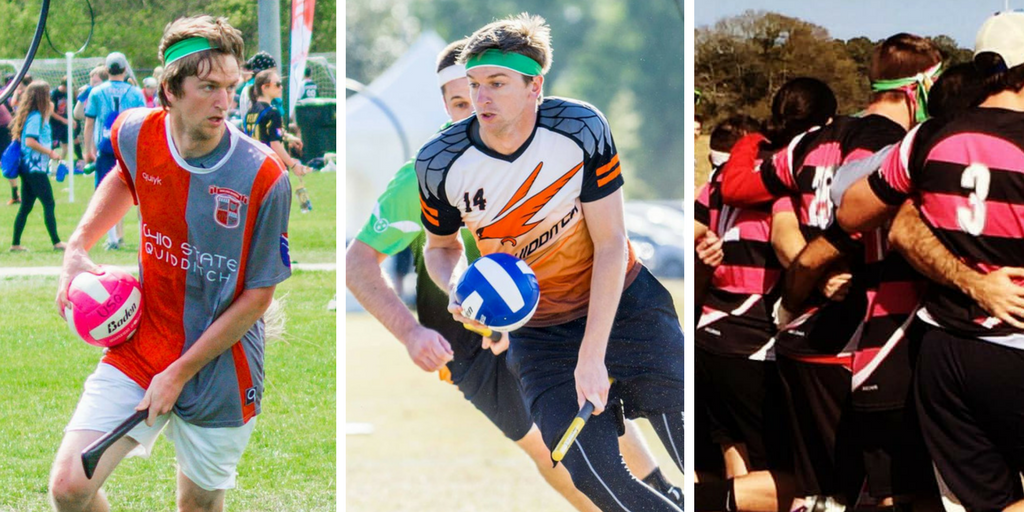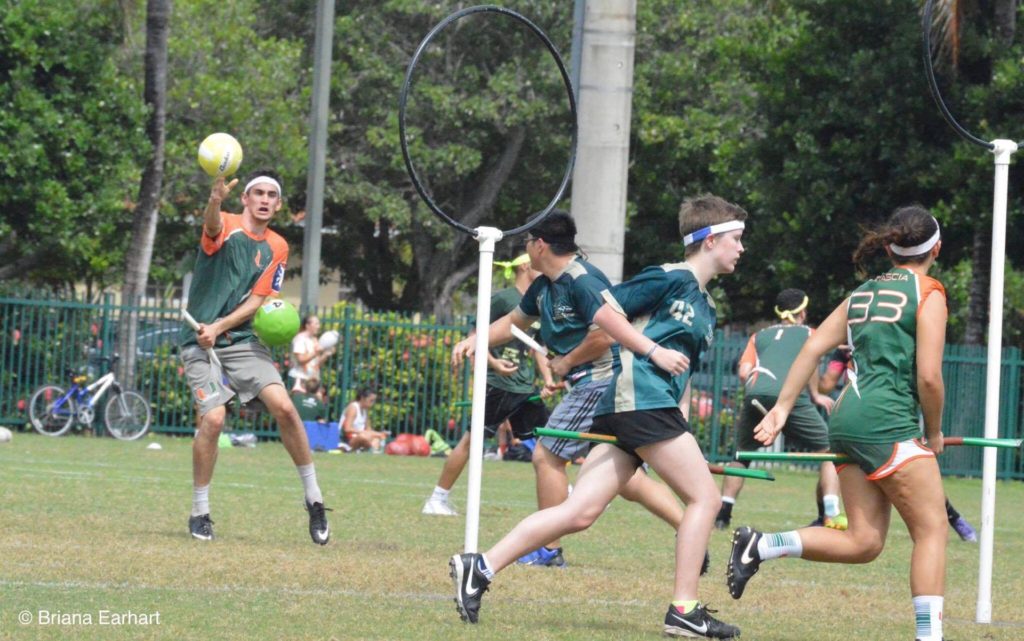Antwerp QC, Much of Belgian Core, Leaves Competitive Quidditch

Credit: Jessica Jiamin Lang, Becca Pollak
As someone who is six years deep into their quidditch career, I surprised myself this season by crossing off a quidditch first: I attended two separate regional championships. As I currently reside in Cincinnati, attending the Great Lakes Regional Championship back in November in Dayton, Ohio was a short 45-minute drive away as a non-playing referee. I stayed active last semester as a non-playing official, watching in-person or officiating close to 40 matches and almost every team in my home region. As someone who is currently conflicted about which team to dedicate themselves to, I’m glad to say my second “retirement” did last a little longer than my first, but when offered the chance to play a short seven-hour drive away in Columbia, S.C. for Florida’s Finest, the bug to play again ended up being too strong.
My experiences in the two regions could not have been more different. I went from being a glorified spectator in the Great Lakes, missing competing at the sport I built so much of my life around in college, to playing in the South and almost losing my lunch due to being woefully out of shape, praying I’d play one shift at most. As an analyst, the contrast of the two regions is even more stark. The Great Lakes only have two community teams in total—one of which, the Falcon Warriors, functions as the Bowling Green State University junior varsity squad; meanwhile, the South is only sending one collegiate team to the national championship—the University of Miami.
The state of collegiate teams in the South is worrisome at best. Miami is obviously still functioning at a high level and shows no signs of slowing in the near future. The College of Charleston—while it did not qualify—does has some great top-end talent and is losing only a handful of players to graduation next season; look for the Cougars to compete for a qualifying spot next spring. Past those two, however, the outlook for collegiate teams in the South is bleak.

Credit: Briana Earhart
This season saw multiple instances of collegiate teams leaving school affiliations behind in attempts to secure qualifying bids and a regional championship title. The University of South Carolina is a perfect example of this, rebranding as the Carolina Heat to round out their roster with community members. The Flying Panthers were consistently referred to as Florida International University, a switch just recently made. Perennial regional contender Tennessee Tech University is nowhere to be found, their members spread between the Panthers and inTENNsity. Even World Cup V runners-up University of Florida find themselves in the same predicament, with most members joining forces with the Gainesville Siege and Florida’s Finest.
The performance of the remaining college teams did not inspire hope for the region’s future. The University of Tennessee Knoxville has the building pieces of a decent beater corps, but really struggled to put points on the board. University of South Florida is years removed from intimidating teams on a national scale with its physical play and lost every game at the regional championship out of snitch range. Looking at the University of Southern Mississippi and the University of Central Florida, you see the same bleak outlook: a lack of necessary athleticism to compete and, notably for Central Florida, a lack of bodies in general. For a region that is currently placing its regional pride in the community scene, the future pool of players outside of Miami and Charleston looks depleted. More effort needs to be made institutionally by teams and players in the region—and USQ for that matter—to develop these younger teams into positions of relative success. Coming from a region that boasts some of the most successful, long-standing collegiate programs in the country—Bowling Green, Ball State University, the University of Michigan and Ohio State, to name a few— it’s troubling to think about exactly how new players in the South will get their opportunity not just to shine, but to at least not feel hopeless on a national stage.
With all of that being said, the South does have the Great Lakes beat in one department: the quidditch down South is infinitely more fun. I’m not completely convinced that it’s better; I think Bowling Green would win a three-game series over Florida’s Finest—which I can say because, again, I’m a traitor—and Ball State the same over the Carolina Heat, with the middle tier of the Great Lakes also considerably more consistent and talented. However, for those of you that think the current meta of top-level quidditch isn’t all that exciting to watch, you have a new group of teams to root for.
In the Great Lakes—and at the rest of the regions who compete for bids in the fall, for that matter—most offensive possessions follow a script that can take a few minutes (in extreme cases) to complete:
- Do my beaters have bludger control? If not, let’s have our keeper hang out near midfield with an easy outlet pass in case they fall under pressure.
- Our two beaters try to isolate a defensive beater and make a play to get control back. If they do not get control, our offense retreats as far as our own hoops while the defense fails to force a turnover, and we head back to the top of the list. Repeat as many times as necessary.
- Our beaters got bludger control back? Excellent. Use both of them to take out the point defender and remaining beater while our best ball handler drives down the path they clear.
- The defense has no bludgers. The ball carrier either dunks, passes off to one of the two open options in the case of a double team or sometimes gets tackled—but only when our beaters have both bludgers and can get them out of the jam.
Assuming that your team is at least almost as athletic as your opponent, there is basically no way to stop that script within the current rules of the game. It’s ruthless, efficient, and definitely the right way to play- while at the same time incredibly boring when you watch both teams use it for all 40 possessions of a game. If Great Lakes gameplay was a food, it would be a quinoa salad with grilled chicken. I understand it’s the right thing to eat, and I know it’s good for me, but I’m absolutely not here by desire alone.
The South’s gameplay is more akin to the KFC Double Down: I’m 90 percent sure that I’m going to die at any given moment, and I know that we should be better as a society, but the ride there is just too much fun to turn down. In my three pool play games with Florida’s Finest, I can count all of the half-court possessions I played with two hands—everything else turned into an impromptu fast break. In the Great Lakes, running a fast break against any amount of armed beaters gets you subbed out by most captains. Southern teams understand that one lone beater—outside of those at the top level in the position—can be overmatched by multiple quick passes, or even by just blocking or dodging a thrown bludger. Beaters in the south are much more likely to use 1.5 beating than any other region, in my experience. Offensive ball carriers seem to not mind silly things like defensive players tackling them.
Does it work every time? Of course not. If anything, the offense in the South is much more inefficient than up north. But the run-and-gun style of play means both teams get more chances to score, while players also tire more easily and the depth of your bench matters much more. Somewhere in the middle of these two regions is the most desired form: enough reliance on athleticism to keep things exciting, and the need for a full roster, while still maintaining enough patience to understand that waiting for the opportune moment to strike is crucial. If only you could watch a regional championship featuring exactly that…
Archives by Month:
- May 2023
- April 2023
- April 2022
- January 2021
- October 2020
- September 2020
- July 2020
- May 2020
- April 2020
- March 2020
- February 2020
- January 2020
- December 2019
- November 2019
- October 2019
- August 2019
- April 2019
- March 2019
- February 2019
- January 2019
- November 2018
- October 2018
- September 2018
- August 2018
- July 2018
- June 2018
- April 2018
- March 2018
- February 2018
- January 2018
- November 2017
- October 2017
- July 2017
- June 2017
- May 2017
- April 2017
- March 2017
- February 2017
- January 2017
- December 2016
- November 2016
- October 2016
- September 2016
- August 2016
- July 2016
- June 2016
- May 2016
- April 2016
- March 2016
- February 2016
- January 2016
- December 2015
- November 2015
- October 2015
- September 2015
- August 2015
- July 2015
- June 2015
- May 2015
- April 2015
- March 2015
- February 2015
- January 2015
- December 2014
- November 2014
- October 2014
- September 2014
- August 2014
- July 2014
- May 2014
- April 2014
- March 2014
- February 2014
- January 2014
- November 2013
- October 2013
- September 2013
- August 2013
- July 2013
- June 2013
- May 2013
- April 2013
- March 2013
- February 2013
- January 2013
- December 2012
- November 2012
- October 2012
Archives by Subject:
- Categories
- Awards
- College/Community Split
- Column
- Community Teams
- Countdown to Columbia
- DIY
- Drills
- Elo Rankings
- Fantasy Fantasy Tournaments
- Game & Tournament Reports
- General
- History Of
- International
- IQA World Cup
- Major League Quidditch
- March Madness
- Matches of the Decade
- Monday Water Cooler
- News
- Positional Strategy
- Press Release
- Profiles
- Quidditch Australia
- Rankings Wrap-Up
- Referees
- Rock Hill Roll Call
- Rules and Policy
- Statistic
- Strategy
- Team Management
- Team USA
- The Pitch
- The Quidditch Lens
- Top 10 College
- Top 10 Community
- Top 20
- Uncategorized
- US Quarantine Cup
- US Quidditch Cup
